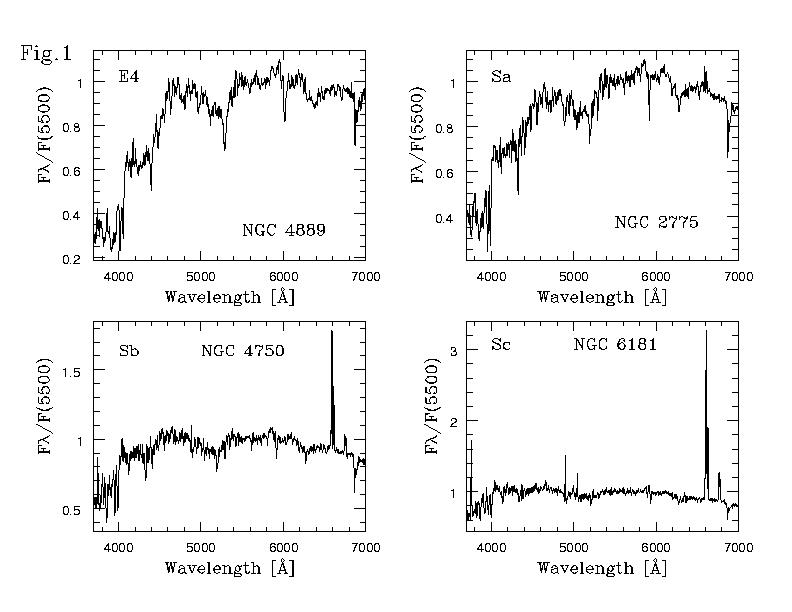 and
and  can
be detected.
can
be detected.
Elliptical galaxies are dominated by an old, evolved stellar population, where
all of the massive, bright and blue main sequence stars have died out,
and have therefore red colours.
They have a very low fraction of cold gas (but can have extended hot,
X-ray emitting gas) and typically exhibit little evidence of star formation.
Most of them show no detectable emission lines at all, although
faint  and
and  can
be detected.
can
be detected.
Elliptical galaxies show relatively homogeneous spectra,
dominated by absorption features from cool giant stars like
 , Na D
, Na D  ,
Ca II K
,
Ca II K  and Ca II H
and Ca II H  .
.
NGC 4889 in Fig. 1 shows the typical spectrum of a bright elliptical.
As a class the spectra of S0 galaxies are nearly indistinguishable
from those of the elliptical galaxies and for both Hubble types
the denomination early-type galaxies is commonly used.

Figure 1: The spectra of galaxies of various
Hubble Types.
A typical feature of early-type galaxies is the discontinuity in their
spectral energy distribution around 4000 Å. This is due to the
sudden onset of stellar photospheric opacity shortward of 4000 Å,
to the Fraunhofer H and K lines of CaII and to a variety of elements
heavier than helium in various stages of ionization. This
discontinuity is called  break index and can be simply
visualized as the ratio of the mean fluxes in two windows above and
below 4000 Å:
break index and can be simply
visualized as the ratio of the mean fluxes in two windows above and
below 4000 Å:

where  is the flux in erg
is the flux in erg  and
and
 Å,
Å,  Å,
Å,
 Å,
Å, Å.
Å.
This index is insensitive to changes in metal abundance
and to the absolute magnitude of the galaxies and
its mean value for nearby early-type galaxies is 2.1 0.1
with a well defined upper envelope value of
0.1
with a well defined upper envelope value of  2.3.
2.3.
If the galaxy has a significant star formation
the young and hot stars present will increase the flux in the ultraviolet
spectral region below 4000 Å causing thus a decrease the  break index.
This sensitivity to the presence of young stars explain why
this index has much lower values in spirals and generally
correlates with the galaxy Hubble type and
with emission features indicative of recent star formation
(blue colors,
break index.
This sensitivity to the presence of young stars explain why
this index has much lower values in spirals and generally
correlates with the galaxy Hubble type and
with emission features indicative of recent star formation
(blue colors,  emission etc..).
emission etc..).